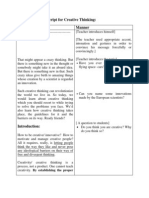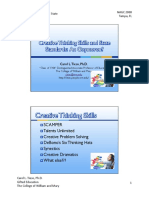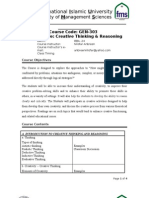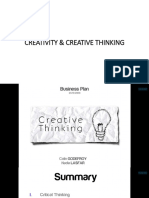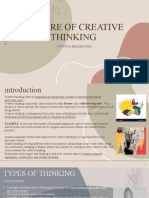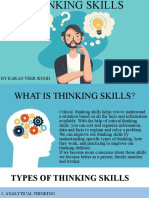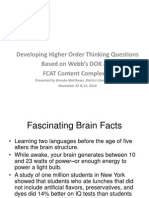Creative Thinking Syllabus Fall 2016
Creative Thinking Syllabus Fall 2016
Uploaded by
Azeema FaizunnisaCopyright:
Available Formats
Creative Thinking Syllabus Fall 2016
Creative Thinking Syllabus Fall 2016
Uploaded by
Azeema FaizunnisaOriginal Description:
Copyright
Available Formats
Share this document
Did you find this document useful?
Is this content inappropriate?
Copyright:
Available Formats
Creative Thinking Syllabus Fall 2016
Creative Thinking Syllabus Fall 2016
Uploaded by
Azeema FaizunnisaCopyright:
Available Formats
1
COMSATS INSTITUTE OF INFORMATION TECHNOLOGY, ISLAMABAD
DEPARTMENT OF HUMANITIES
SYLLABUS
Creative Thinking & Decision Making (BPY III) Fall 2016
Day/Time: Mon/Tue 1:00-2:30 PM
Instructor: Azeema Faizunnisa Vogeler, PhD, University of Hawaii
Email: azeema@gmail.com
Office Hours: By appointment.
Course Description:
This course outline has been compiled to meet the needs of students studying Creative
Thinking and Decision Making as a compulsory subject for undergraduate level students
of Psychology in CIIT, Islamabad. This is a 3 credit hour course, comprising 3 hours of
teaching per week.
Course Objectives:
The aim of this course is to develop a conceptual clarity about thinking creatively and
decision making, and how these concepts are manifested in studies as well as in
professional and personal life.
After studying this course the participants should be able to:
Identify various styles of thinking and explain how these thinking techniques
apply to creativity and decision making.
To become an active creator of their own knowledge base by becoming a learner
through direct observations of examples in daily life.
Apply various perspectives to collective behavior, human social need, and
individual social and personal life.
Class Participation:
Throughout the semester, there will be opportunities to earn participation points through
intelligent engagement in class activities. There will be various assignments to enhance
the understanding of course materials.
Assignment guidelines:
All written assignments are expected to be processed according to APA guidelines (refer
to Perdue night owl APA) before they are turned in for grade. All work is expected to be
turned in as hard copy with names of student and teacher, class and section, date, and
assignment title on the left hand top corner of the first page in single space; the rest of the
text typed and double spaced on a 12 font, Times Roman, and duly stapled. No
handwritten, emailed, or unstapled work is ever accepted in this class.
Note: No late quizzes or presentations without documented reasons for absence.
Methods of Teaching:
Lectures, case studies, small group discussions.
Relevant projects and other activities like role play
Reading materials and lectures will be occasionally supplemented with relevant
videos and other materials
Grading:
Participation in class, assignments, projects
and quizzes
Sessional 1
Sessional 2
Final Exam
25 points
10 points
15 points
50 points
Tentative schedule
Lecture 1
Lecture
Lecture
Lecture
Lecture
Lecture
Lecture
2
3
4
5
6
7
Lecture 8
Lecture
Lecture
Lecture
Lecture
Lecture
Lecture
Lecture
9
10
11
12
13
14
15
Lecture 16
Lecture 17
Lecture 18
Introduction of class, syllabus, objectives, activities
during the semester
What is creativity? Class discussion (individual
assignment on plastic free weekend)
Basics of critical thinking and logic/reasoning
Arguments, premises, logical fallacies
Exercises: Arguments, premises, logical fallacies
Persuasion including ethos, pathos and logos
Solving logic puzzle and games
Cultural hegemony and ideology formation, discourse
creation, agency
Celebrating culture (with assignment on how and why
cultures shift)
Ethical Dilemmas & Decisions
Concept mapping, process maps
Stakeholder analysis
Lateral thinking (6 thinking hats) of Edward Bono
Hegemony, subalterns and human agency
Public policy in Pakistan (guest lecture)
Objectification of women, gender sub-texts, analyzing
ads for subliminal messages
Analysis of advertisements, class presentations
Who is a hero and why? How we choose our heroes?
Class write up and presentations on unknown heroes
Lecture 19
Lecture 20
Lecture 21
Lecture 22
Lecture
Lecture
Lecture
Lecture
Lecture
Lecture
Lecture
Lecture
23
24
25
26
27
28
29
30
from Pakistan.
Gambit
Reasoning styles including inductive/deductive
Ethics, thinking about our moral compass (Steven
Pinker article)
Pinker article and SWOT analysis
What is vested Interest and other topics related to
creative writing
Necessary and sufficient conditions
Science vs. Pseudoscience, Gambit exercise
Misc. topics: zero sum game, paradox, oxymoron
Student presentations on selected articles
Student presentations on selected articles
Student presentations on selected articles
Student presentations on selected articles
Important notes: If you have any physical disability or circumstantial hindrance which
will make it difficult for you to carry out the work outlined and/or if you need special
accommodations due to the disability, please contact me immediately so that appropriate
arrangements/accommodations can be arrange, if possible.
Use of cell phones and other electronic device are not allowed in the class unless advised
by the instructor.
Please make sure that your work is plagiarism free. If you have any
questions on what entails plagiarism, please contact me.
You might also like
- Biography - Applied Channel Theory Research CenterDocument1 pageBiography - Applied Channel Theory Research CenterCarlos Estrada Marzo100% (1)
- BSBINN502 - Task 1 - Part 2Document11 pagesBSBINN502 - Task 1 - Part 2Carla Jeanne Kindahan100% (2)
- Creative Thinking Techniques-1Document24 pagesCreative Thinking Techniques-1CarmenLarisaNo ratings yet
- Packtypes Creative Curriculum SkillsDocument10 pagesPacktypes Creative Curriculum SkillsChrisRaymondNo ratings yet
- The Presentation Script For Creative Thinking (Updated)Document9 pagesThe Presentation Script For Creative Thinking (Updated)Jadhav Nilesh AshokNo ratings yet
- PDC 2 CSDocument4 pagesPDC 2 CSszeyee1205No ratings yet
- Assignment-2 (Design Thinking)Document12 pagesAssignment-2 (Design Thinking)ANURAG SHUKLANo ratings yet
- Creative Thinking SkillsDocument14 pagesCreative Thinking SkillsYoona ChanNo ratings yet
- Course Outline For Creative Thinking Fall 2011Document4 pagesCourse Outline For Creative Thinking Fall 2011Afnan HafeezNo ratings yet
- Creative Thinking ToolsDocument31 pagesCreative Thinking ToolsSandra VujovicNo ratings yet
- Nature of Creative ThinkingDocument7 pagesNature of Creative Thinkingharshita sehrawatNo ratings yet
- Creative Thinking Lesson FinalDocument6 pagesCreative Thinking Lesson Finalapi-206139354No ratings yet
- Cross-Cultural Effectiveness of Western Expatriate Thai Client Interactions Lessons Learned For IHRM Research and TheoryDocument25 pagesCross-Cultural Effectiveness of Western Expatriate Thai Client Interactions Lessons Learned For IHRM Research and TheoryLinh HoangNo ratings yet
- Project-Based Learning: Presented By: Joana Mae T. LorenzanaDocument28 pagesProject-Based Learning: Presented By: Joana Mae T. LorenzanaJoana Mae LorenzanaNo ratings yet
- Creative Thinking Lecture 2Document17 pagesCreative Thinking Lecture 2Sara KhanNo ratings yet
- Creative Thinking: 1. Open The FloodgatesDocument4 pagesCreative Thinking: 1. Open The FloodgatesAnnelies PoppeNo ratings yet
- (第一天)每日教学教案Document5 pages(第一天)每日教学教案William KwongNo ratings yet
- Module 5 - Problem Solving and Creative ThinkingDocument14 pagesModule 5 - Problem Solving and Creative ThinkingNikhil JadhavNo ratings yet
- Creative Thinking MethodsDocument6 pagesCreative Thinking MethodsidrisNo ratings yet
- Case Study IT Project MGMTDocument4 pagesCase Study IT Project MGMTvettithala100% (1)
- 第一课 动物大迁徙有感 每日教学计划Document5 pages第一课 动物大迁徙有感 每日教学计划LUCK TECK HUN MoeNo ratings yet
- By Karan Veer Singh BBA-2 SemDocument10 pagesBy Karan Veer Singh BBA-2 Semwild worldNo ratings yet
- Thinking Skills: Name: T. Yoga Ujwala Registration Number: 17BEC0577 Slot: TG1Document15 pagesThinking Skills: Name: T. Yoga Ujwala Registration Number: 17BEC0577 Slot: TG1Yoga Ujwala ThatavarthiNo ratings yet
- Cdio Creative Thinking RubricDocument2 pagesCdio Creative Thinking Rubricshamsukarim2009No ratings yet
- Decision Making ReportDocument27 pagesDecision Making ReportHarold Mantaring LoNo ratings yet
- Practice Divergent and Convergent ThinkingDocument1 pagePractice Divergent and Convergent ThinkingAdil HussainNo ratings yet
- New Directions in Strategic ThinkingDocument20 pagesNew Directions in Strategic ThinkingNAIM100% (1)
- Creative Thinking SyllabusDocument11 pagesCreative Thinking SyllabusMohd Kamarulzaman OmarNo ratings yet
- Creative ThinkingDocument18 pagesCreative ThinkingshivamNo ratings yet
- Convergent and Divergent ThinkingDocument7 pagesConvergent and Divergent ThinkingdonsNo ratings yet
- Bina Ayat 2Document48 pagesBina Ayat 2Chung Huey100% (1)
- Find or Register As Tutor, Tuition Centre, College, University, Enrichment Classes, Pre School and Etc. at Get More Free Exercises and Notes atDocument5 pagesFind or Register As Tutor, Tuition Centre, College, University, Enrichment Classes, Pre School and Etc. at Get More Free Exercises and Notes atSarah KuanNo ratings yet
- Creativity Is Thinking New ThingsDocument3 pagesCreativity Is Thinking New ThingsAhsan Zaman SuzaNo ratings yet
- Y1 Grammar ExercisesDocument14 pagesY1 Grammar ExercisesCHONG MEI KUAN MoeNo ratings yet
- Year 3 Step by Step Writing Module Part 3Document32 pagesYear 3 Step by Step Writing Module Part 3zalinaNo ratings yet
- Monthly Exam Paper 2 Year 4 2019Document13 pagesMonthly Exam Paper 2 Year 4 2019jaivandhanaaNo ratings yet
- Find or Register As Tutor, Tuition Centre, College, University, Enrichment Classes, Pre School and Etc. atDocument5 pagesFind or Register As Tutor, Tuition Centre, College, University, Enrichment Classes, Pre School and Etc. atSze Nee 思妮No ratings yet
- The 5 Stages in The Design Thinking ProcessDocument5 pagesThe 5 Stages in The Design Thinking Processhervehirwa25No ratings yet
- English Grammar 9 and Reading ComprehensionDocument4 pagesEnglish Grammar 9 and Reading ComprehensionYuri HeahNo ratings yet
- Creative Thinking and Critical ThinkingDocument12 pagesCreative Thinking and Critical ThinkingJulie Ann Benosa100% (1)
- Innovation and Creativity Lec TwoDocument14 pagesInnovation and Creativity Lec TwobenNo ratings yet
- Higher Order Thinking QuestionsDocument46 pagesHigher Order Thinking QuestionsAmar Minz0% (1)
- Assessing Creativity and Creative Thinking ScriptDocument5 pagesAssessing Creativity and Creative Thinking ScriptOnyakNo ratings yet
- Learner Agency Full ToolkitDocument17 pagesLearner Agency Full ToolkitAngel GiranoNo ratings yet
- Creative Thinking ExerciseDocument47 pagesCreative Thinking ExerciseAmir M. VillasNo ratings yet
- Design Thinking - IDEO Case StudyDocument35 pagesDesign Thinking - IDEO Case StudyOperations Club NCRNo ratings yet
- 1 - Higher Order Thinking Questions Preso PDFDocument34 pages1 - Higher Order Thinking Questions Preso PDFlapokNo ratings yet
- Thinking Routines MatrixDocument1 pageThinking Routines Matrixapi-252888343No ratings yet
- KSSR Superminds Year 2Document21 pagesKSSR Superminds Year 2Kok Chen LeeNo ratings yet
- Find or Register As Tutor, Tuition Centre, College, University, Enrichment Classes, Pre School and Etc. at Get More Free Exercises and Notes atDocument6 pagesFind or Register As Tutor, Tuition Centre, College, University, Enrichment Classes, Pre School and Etc. at Get More Free Exercises and Notes atwong ai bingNo ratings yet
- There Are Three Questions in This Paper. Answer All Questions in The Space Provided. (10 Marks)Document7 pagesThere Are Three Questions in This Paper. Answer All Questions in The Space Provided. (10 Marks)Piya ShneNo ratings yet
- Empowerment & PaticipationDocument20 pagesEmpowerment & PaticipationAnalyn DyNo ratings yet
- 三年级华文练习 SAP PDFDocument107 pages三年级华文练习 SAP PDFDivahse100% (1)
- PMR SPM Essay Part 2Document19 pagesPMR SPM Essay Part 2manbitt1208No ratings yet
- Personal Branding WebinarDocument26 pagesPersonal Branding WebinarOnah EmmanuelNo ratings yet
- 7° Cuadernillo de Ingles 2024Document32 pages7° Cuadernillo de Ingles 2024Gelana MisionesNo ratings yet
- Y2 English May Extra RevisionDocument14 pagesY2 English May Extra RevisionjasonNo ratings yet
- Lean Workshop 1Document22 pagesLean Workshop 1dissidentmeNo ratings yet
- PMR English EssayDocument2 pagesPMR English Essayb71bpjha100% (2)
- Course Outline - Cognitive PsychDocument4 pagesCourse Outline - Cognitive PsychJeng Mun SamNo ratings yet
- (Rodger W. Bybee) Learning Science and The ScienceDocument167 pages(Rodger W. Bybee) Learning Science and The ScienceIbnul Mubarok100% (2)
- A Background Study About CalculusDocument3 pagesA Background Study About CalculusAnn Del RosarioNo ratings yet
- Relationship Marketing and The Markets As Networ - 241111 - 170808Document16 pagesRelationship Marketing and The Markets As Networ - 241111 - 170808exchangesarah228No ratings yet
- 2 CHET Et Al Vol 2 Issue 2Document5 pages2 CHET Et Al Vol 2 Issue 2Mr. ComplementizerNo ratings yet
- List of Prescribed Books For APSs - Nov 2021Document2 pagesList of Prescribed Books For APSs - Nov 2021Mail ManNo ratings yet
- Ontology LogicDocument843 pagesOntology Logicsdm_pedro100% (7)
- Kelompok 6 - Evidence Based PracticeDocument37 pagesKelompok 6 - Evidence Based PracticeRiska Eldyani100% (1)
- Health System ResearchDocument52 pagesHealth System ResearchMuhammad Ibtsam - PharmDNo ratings yet
- Perceived Effects of Mobile Phones On The Academic Performancee of The College of Teacher Education StudentsDocument12 pagesPerceived Effects of Mobile Phones On The Academic Performancee of The College of Teacher Education Studentsaries jarabeseNo ratings yet
- Batch 2/2025: Topic Wise Test Series With Daily Planner (Notes Included)Document13 pagesBatch 2/2025: Topic Wise Test Series With Daily Planner (Notes Included)naveen.jain28495No ratings yet
- Philippine Politics and GovernanceDocument95 pagesPhilippine Politics and GovernanceRish Romero75% (4)
- Organizational Politics and Change A Conceptual MoDocument22 pagesOrganizational Politics and Change A Conceptual MomadihaNo ratings yet
- Sample Mitchell Scholarship Recommendation - 2Document2 pagesSample Mitchell Scholarship Recommendation - 2Ryan Rizki RaseptaNo ratings yet
- Chemistry Quick Lab Sugar Density LayersDocument3 pagesChemistry Quick Lab Sugar Density LayersCarla MirandaNo ratings yet
- Analisis Kesulitan Siswa Kelas Xi Dalam Menyelesaikan Soal Fungsi Komposisi Dan Fungsi Invers Di SMK Al-Ikhsan BatujajarDocument14 pagesAnalisis Kesulitan Siswa Kelas Xi Dalam Menyelesaikan Soal Fungsi Komposisi Dan Fungsi Invers Di SMK Al-Ikhsan BatujajarCho NisaaNo ratings yet
- Early Ideas About The Origin of Species: Plato 428-348 BCDocument23 pagesEarly Ideas About The Origin of Species: Plato 428-348 BCClass MasterNo ratings yet
- Practical Research Group 6Document5 pagesPractical Research Group 6Kylene MagtibayNo ratings yet
- OpticsDocument2 pagesOpticsPrasanthNo ratings yet
- Quiz No. 2Document2 pagesQuiz No. 2Kath Tan AlcantaraNo ratings yet
- Moi University College of Health ScienceDocument16 pagesMoi University College of Health ScienceWorkPlace Health&SafetyNo ratings yet
- Methods of Research-Final Examination: Panpacific University Graduate School (February 2023)Document4 pagesMethods of Research-Final Examination: Panpacific University Graduate School (February 2023)Riane GuiebNo ratings yet
- Major Schools of Thought in PsychologyDocument4 pagesMajor Schools of Thought in PsychologyPM Keshav100% (1)
- Schrödinger Equation Family PDFDocument26 pagesSchrödinger Equation Family PDFDelos NourseiNo ratings yet
- Guggenmos 2020Document38 pagesGuggenmos 2020Christian M Nino-Moris FANo ratings yet
- Assessment in ScienceDocument10 pagesAssessment in ScienceMarilyn Castro Laquindanum100% (1)
- Career Option After PCMDocument5 pagesCareer Option After PCMPrashant TyagiNo ratings yet
- Statistics and Probability WEEK 4Document13 pagesStatistics and Probability WEEK 4Elvin PretencioNo ratings yet
- Research and Theory in Current Archeology: Charles RedmanDocument14 pagesResearch and Theory in Current Archeology: Charles RedmanTeresita CeaNo ratings yet
- How To Write A Scientific Manuscript For PublicatiDocument11 pagesHow To Write A Scientific Manuscript For PublicatiHaile SolomonNo ratings yet




